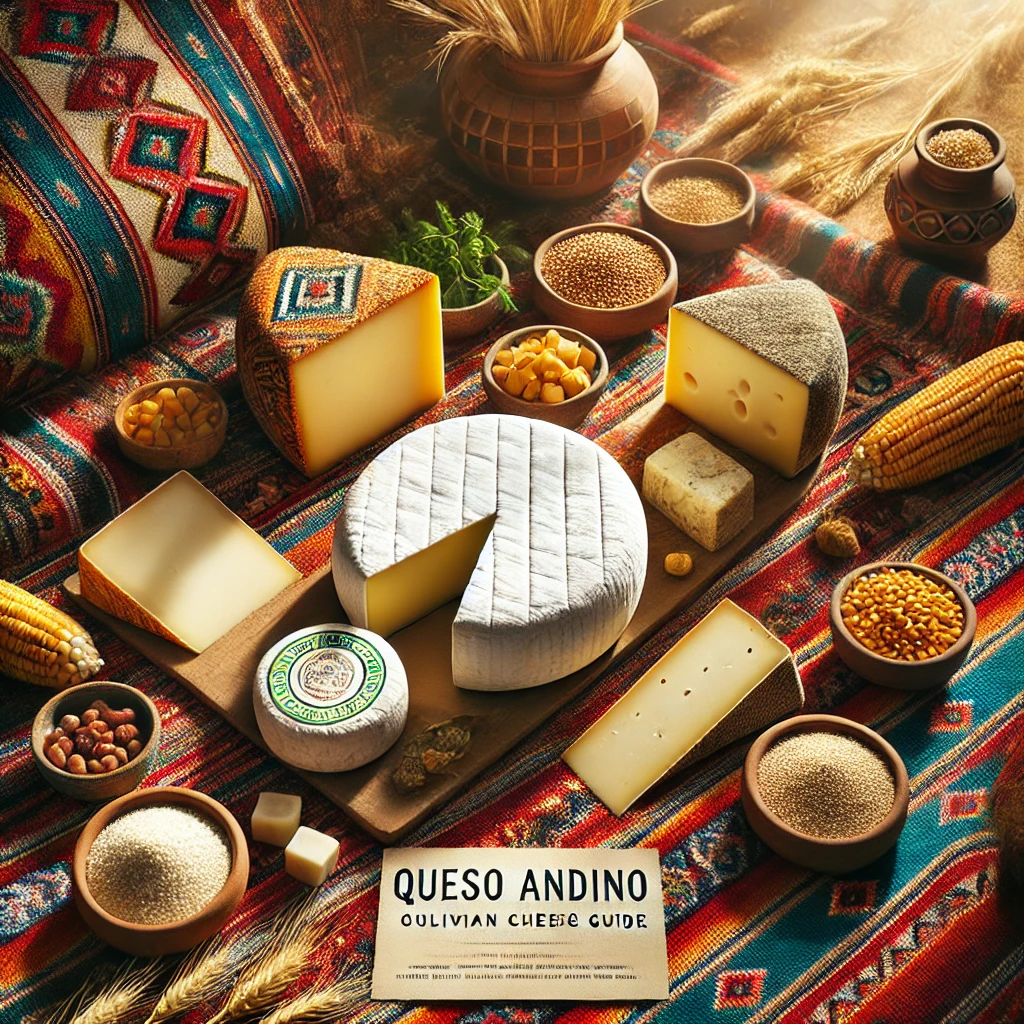A Taste of the Andes: What Makes Queso Andino Special
High in the Bolivian Andes—where the air turns crisp, the sun is gentle, and rural traditions remain strong—cheese occupies a humble yet meaningful place in everyday life. One of the most beloved regional cheeses is Queso Andino, a semi-hard, fresh cheese crafted largely in the valleys and altiplano towns where milk is plentiful and the land offers natural coolness for small-scale dairy production.
If you’ve ever traveled through Bolivia, you may remember market stalls selling white blocks of cheese wrapped in cloth or resting in woven baskets. That unmistakable cheese, firm yet fresh, simple yet satisfying, is frequently Queso Andino.
This cheese represents the spirit of the Andes—resourceful, rustic, and refreshingly authentic.
What Is Queso Andino?
Queso Andino is a semi-hard, fresh cheese traditionally made from pasteurized cow’s milk. While the cheese is firm enough to slice, it retains moisture and a gentle springiness, making it extremely versatile.
Unlike many aged European cheeses, Bolivian Andean cheese is usually eaten within days of production. Its freshness preserves the natural milk flavor and makes it ideal for both cooking and snacking.
Key characteristics:
-
Mild, clean flavor
-
Firm but not crumbly
-
Low salt level (varies by region)
-
Pale white interior
-
Smooth, compact texture
The simplicity of the cheese is part of its charm—it doesn’t strive to be complex; it strives to be honest.
Origins: The Andean Dairy Tradition
Dairy has been part of Andean life for generations. Even though cattle arrived with the Spanish, indigenous communities quickly integrated dairy farming into their mountain lifestyles. The cool temperatures of the altiplano provided natural conditions for preserving fresh dairy, long before refrigeration became available.
Queso Andino evolved as a practical cheese:
-
Made quickly
-
Easy to store
-
Ideal for local diets
-
Adaptable to many dishes
In many rural areas, families still produce it artisanally. Milk from local cows—fed on natural Andean grasses—results in a richer, more aromatic curd compared to industrial dairy.
The cheese also reflects Bolivia’s cultural mosaic, combining Spanish cheesemaking techniques with indigenous tradition.
How Queso Andino Is Made
Although each community may have its own method, the core process remains similar. It’s simple, efficient, and rooted in traditional craftsmanship.
Step 1: Heating the Milk
Fresh cow’s milk is gently heated until warm, not boiling.
Step 2: Coagulation
Rennet is added so the milk slowly thickens into curds.
Step 3: Cutting the Curds
The curds are hand-cut or sliced with a tool to release whey.
Step 4: Pressing
Curds are collected into molds or cloth bags and pressed. This step gives the cheese its firmness.
Step 5: Salting
Some producers lightly brine the cheese, while others mix salt directly into the curd.
Step 6: Resting
After pressing, cheese is rested for a short time—often less than 48 hours—before being sold at markets.
This minimal aging contributes to its fresh dairy aroma and soft bite.
Flavor Profile: What Does Queso Andino Taste Like?
Queso Andino is admired for its gentle flavor, making it a favorite for both locals and chefs exploring Andean cuisine.
Tasting Notes
-
Lightly salty
-
Clean, milky taste
-
Slight sweetness from fresh cow’s milk
-
Soft acidity
-
Mild aroma
Texture Notes
-
Firm but yielding
-
Smooth surface
-
Sliceable
-
Moist without being wet
You can think of it as sitting somewhere between queso fresco and a young semi-hard cheese, but with its own Bolivian identity.
Types & Regional Varieties
Bolivia’s diverse climates mean that Queso Andino varies depending on where it’s made.
1. Andino Cheese from Cochabamba
Often a bit saltier and firmer, ideal for grilling.
2. Queso Andino Paceño (La Paz)
Mild with a softer texture due to cooler temperatures.
3. Vallegrande-Style Andean Cheese
Sometimes slightly aged for deeper flavor.
4. Queso Fresco Boliviano
Though not the same as Queso Andino, many vendors use the terms loosely. Queso Fresco is wetter and more crumbly.
5. Artisan Andean Cheese
Handmade versions often have richer flavor, reflecting grass-fed milk.
While these variations aren’t officially classified, Bolivians instantly recognize the differences.
How Queso Andino Is Used in Bolivian Cuisine
One of the reasons Queso Andino remains popular is its adaptability. You’ll find it across the country in daily cooking, snacks, and even festival foods.
Here are some favorite uses:
1. Slicing for Snacks
Served with bread, crackers, or simply eaten alone.
2. Grilling
Andean cheese holds up surprisingly well on a hot pan or grill. When lightly seared, it develops a golden crust while staying soft inside—similar to halloumi but milder.
3. Cooking in Traditional Dishes
Bolivians use Queso Andino in:
-
Humintas (sweet corn cakes wrapped in husk)
-
Tawa-tawas
-
Empanadas
-
Soups
-
Llajua-topped snack plates
4. Breakfast Cheese
A simple slice with freshly baked bread and herbal tea is common in rural areas.
5. Melting into Sauces
Though not a perfect melter, it softens beautifully in warm dishes.
Pairing Ideas: Foods and Drinks That Complement Queso Andino
Although mild, Queso Andino pairs beautifully with both traditional and modern flavors.
Food Pairings
-
Fresh tomatoes
-
Avocado
-
Salteñas
-
Quinoa salads
-
Grilled vegetables
-
Roasted potatoes
Flavor Pairings
-
Chili sauces (llajua)
-
Honey
-
Herbs like parsley or oregano
-
Citrus dressings
-
Roasted corn
Drink Pairings
-
Bolivian herbal teas (mate de coca, anise)
-
Light lagers
-
White wines like Sauvignon Blanc
-
Fresh juices (maracuyá, tumbo)
Pairings highlight the cheese’s milk-forward simplicity rather than overpowering it.
Nutrition Profile
Fresh, minimally processed cheeses like Queso Andino offer several nutritional benefits.
Rich Source Of:
-
Protein
-
Calcium
-
Vitamin A
-
Healthy fats
-
Phosphorus
Digestibility
Queso Andino is easier to digest than long-aged cheeses because of its lower salt level and mild acidity.
Caloric Content
Moderate, depending on fat percentage.
Overall, it’s a wholesome addition to meals—especially when paired with grains, vegetables, or legumes.
How to Store Queso Andino
Because it’s a fresh cheese, proper storage is essential.
Short-Term Storage
-
Wrap in parchment or light plastic
-
Keep refrigerated
-
Consume within 4–7 days
Freezing?
Not recommended. Texture can become crumbly.
Market-Bought Cheese
Always ask vendors whether it is salted or unsalted; saltier versions last longer.
Where to Buy Queso Andino
In Bolivia
-
Traditional markets in La Paz, Sucre, Cochabamba
-
Dairy cooperatives
-
Roadside village stalls
-
Local grocery stores
Outside Bolivia
It’s rare but sometimes available in:
-
Latin American grocery stores
-
Farmers markets run by Bolivian communities
-
Specialty cheese retailers focusing on global or artisanal products
Some chefs make homemade versions inspired by the traditional recipe.
Queso Andino vs. Other Andean Cheeses
There are various cheeses across the Andean world, but Queso Andino stands apart from:
| Cheese | Origin | Key Differences |
|---|---|---|
| Queso Fresco | Latin America | Wetter, crumbly, softer flavor |
| Halloumi | Middle East | Much saltier, firmer, squeaky texture |
| Quesillo Peruano | Peru | Stringier and softer |
| Queso Paceño | Bolivia | Fresher and lighter compared to firm Queso Andino |
These comparisons highlight its unique position among semi-hard, fresh cheeses.
Why Queso Andino Matters in Bolivian Food Culture
Cheese may not be the first food associated with Bolivia, but Queso Andino plays a quiet but meaningful role in everyday meals. It reflects:
-
The country’s rural milk economy
-
Pride in Andean craftsmanship
-
A focus on fresh, minimally processed foods
-
Traditional cooking techniques kept alive across generations
Even as supermarkets and global foods enter the market, Queso Andino remains firmly rooted in Bolivian kitchens.
Conclusion: A True Bolivian Classic
Queso Andino isn’t flashy or exotic—it doesn’t need to be. It is honest, simple, nourishing, and deeply tied to the Andean landscapes where it is born.
Whether sliced over breakfast, grilled for lunch, or folded into a warm empanada, this cheese captures the soul of Bolivian cooking. For food lovers seeking authentic flavors, Queso Andino offers a delicious glimpse into the heart of the Andes.



